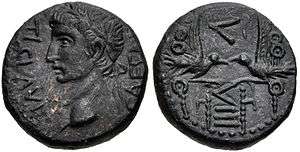Legio VIII Augusta



Legio octava Augusta ("Augustus' Eighth Legion") was one of the oldest legions[1] of the Imperial Roman army founded by Pompey in 65 BC, along with the 6th, 7th & 9th, and continuing in service to Rome for at least 400 years thereafter.[2]
In republican service
They were ordered to Cisalpine Gaul around 58 BC by Julius Caesar, and marched with him throughout the entire Gallic Wars. In 49, at the very beginning of the civil war between Caesar and Pompey, the Eighth Legion accompanied Caesar across the Rubicon into Italy. They stood with him at the Battle of Pharsalus. The legion was also present in Egypt, when Caesar captured Egypt for Cleopatra. In 46 BC the legion took part in the Battle of Thapsus (modern Tunisia), shortly before their disbandment.
In 44 BC, Augustus reconstituted the legion which had helped him attain the control of the Empire. This loyalty gave the legion the cognomen Augusta.
In imperial service
Around 45 AD the VIII Augusta took part in the suppression of the Thracian uprising,[3] and founded its castrum at Novae where the Danube has its most southern bend and from where the legion controlled a long section of the Danube.
In 69 AD, the Year of the Four Emperors, following the suicide of Nero, the legion took the side of Vespasian, the new emperor.
The legion went with Vespasian to Mirebeau-sur-Bèze[4] in Gaul in 70 AD to oppose the revolts of the Treveri and especially the Ubii and Lingons against Rome, and where it built its new base.[5]
The legion left in 86 AD, at latest, to its next base at Argentoratum (Strasbourg).
The legion also fought in Parthia with Septimius Severus (who ruled from 193 until 211) and with his successors.
Records indicate that they were still active during the first years of the 4th century at the Rhine frontier. This means that the history of the legion covers more than 400 years of almost continuous service. In 371 it was stationed in Argentoratum (Strasbourg), in Germania Superior, according to an inscription. Later, the Roman general Stilicho, was compelled to move the German legions back to Italy to defend it against the Visigothic invasion.
According to Notitia Dignitatum, around 420 an Octaviani unit was under the Magister Peditum of Italia; it is possible that this unit was the old VIII Augusta, which was originally a comitatensis unit, but that had been promoted to palatina status.
Epigraphic inscrptions
- ri[…] G̣allorum tribunus militum legionis VIII Augustae. Cohort of Gauls, military [tribune] of the Eighth Legion Augusta. Brougham (Brocavum). CIL VII 300 = RIB 782.
See also
References
- ↑ http://www.livius.org/articles/legion/legio-viii-augusta/?
- ↑ Caesar's Legion, Stephen Dando-Collins, 269-270
- ↑ J. KOLENDO, Claude et l’annexion de la Thrace, in: Claude de Lyon empereur romain. Actes du Colloque Paris-Nancy-Lyon. Novembre 1992, Paris 1998.
- ↑ http://www.legionaryfortresses.info/index.htm
- ↑ Le camp légionnaire de Mirebeau (Goguey, Reddé, 1995)
External links
- livius.org account
- (German) VEX LEG VIII AVG, German re-enactment society
- (French) LEGION VIII AUGUSTA, French re-enactment society
- LEGIO VIII AUGUSTA, US re-enactment society
- LEGIO VIII AVGVSTA MGV, British re-enactment society
- Octaviani in Notitia Dignitatum
